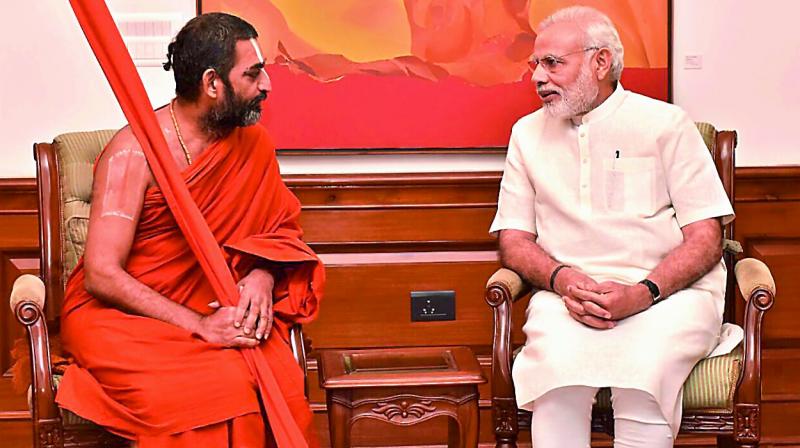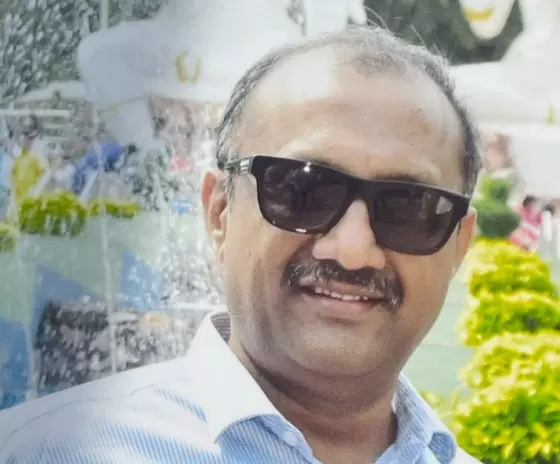Hinduism is most democratic philosophy of mankind, says Chinna Jeeyar Swami

Hyderabad: In the modern world of paradoxes, globalisation is creating opportunities and wealth for both nations and individuals and yet is seemingly floundering — a panacea, yet a menace. As income and socio-political inequalities are ever-increasing, the philosophy of “equality” as preached by Sri Ramanujacharya over 1,000 years ago has greater relevance to the modern world today, and for the future, says Sri Sri Tridandi Chinna Srimannarayana Ramanuja Jeeyar Swami.
With the inauguration of the 216-foot-tall Statue of Equality by Prime Minister Narendra Modi in February next year at his ashram near Hyderabad international airport, the dream of Sri Chinna Jeeyar Swami to take the profound wisdom and theological as well as social reformative contributions of Sri Ramanujacharya to the mankind at large, and especially to the younger generations on a “really big in scale”, is all set to become a reality.
Chinna Jeeyar Swami is one of India’s greatest living scholars and teachers of Vedic and Sanatan wisdom, who is known for his simplicity as also for his kindness and accessible nature.
Sitting on the floor at his small kuteer, an ordinary structure without the trappings of pomp that is commonplace with contemporary spiritual gurus, the Swami shared his views on the philosophy of equality, on the insights from the Vedas, the globalisation, Hinduism and the perceptible threats to the Sanatana dharma from the large-scale and organised religious conversions.
He also spoke about the historic and spiritually inclined ethos of the people of Telangana and the re-building of the Yadadri Temple, among other matters, in an exclusive interview with Deccan Chronicle.
Here below are excerpts from the interview.
Q: What is the relevance of Rama-nujacharya’s philosophy in today’s world? How do you wish to take his message to the present and future generations?
Technology, situations, attitude and financial status of a people may change but they will always breathe, eat, drink and sleep – these are eternal human truths. In a similar vein, the philosophy Ramanuja offered to the world, like a natural phenomenon, is relevant even after a thousand years.
What we see in today’s world is selfishness, a fight for domination and craving for possessions. The expansionist tendency is seen equally strongly in individuals and nations in this era of globalisation.
Q: But, globalisation is the order of the day….
Nothing explains globalisation better than the concept of “Vasudaika Kutumbakam” (all living world is one family) as is preached in our Vedas. We have always had an Indic tradition of globalisation. In Ramayana, we see that Rama never tried to establish his rule over other kingdoms though he had an opportunity to do so – whether in Kishkinda after killing Vali, or Lanka after killing Ravana. He left it to the populace to continue with their rule aligned to their own culture and traditions. It was this texture of globalisation that India offered to the world. We need to understand, cherish, and protect Sanatana Dharma so that we may pass it on to the coming generation in the spirit of truth, knowledge and a legacy.
Q: Whenever Sanatana Dharma is in question, critics refer to the biggest problem the Hindu society suffers from, the caste system, a reflection of inequality?
Again refer to Rama’s philosophy of working with humans in Ayodhya, apes in Kishkinda and demons in Lanka – if you like to see them as diversities of caste, race, colour, attitude, ethos and cultural norms. Yet, there was coexistence, a way to help each other, cohabit, in a sustainable way. Caste system was referred to in the Vedas but not meant to be misinterpreted to be used politically to oppress a particular section. It was to share responsibilities and live cohesively.
This is where Ramanuja’s core philosophy of co-existence of “sareera” (body) and “sareeri” (soul) has to be understood properly to understand the world. There are, and must be, opportunities for everyone, and an equal chance has to be made available for all to gain. If we consider the universe as one body, no limb tries, or should try, to dominate another; yet, each organ has its difference, its specific function; none superior, yet each vital for larger harmony.
Q: A section of the people fear that Hinduism is under threat, mainly due to religious conversions. What is your view, you being one of the most influential modern day Hindu saints, on conversions?
A proper ideology and philosophy, not influenced by politics, but professing and inculcating values and showing the purpose of life is crucial. The Vedas preached such a philosophy. Unfortunately, the Vedas too were either misinterpreted or partly interpreted. Ramanuja integrated their wisdom and preached them in their entirety. There are other philosophies that fight to dominate but Indic philosophy shares pain and joy and leads a person to a fair goal of union with Brahma, to experience divine joy.
Q: But why a statue? In olden days, temples were built as part of propagating the religion or ideology. What does the Statue of Equality signify?
Even during Ramanuja’s days, when mantra, (a mode of communication), was highly restricted, it was not an ordinary task to propagate his philosophy. He toured the entire country and tried to enlighten other rulers and the ruled. He showed the relevance of this wisdom not as an esoteric indulgence but in a common light. In the days of Google… people are looking for the exceptional (a large smile lights up his face impishly)… the biggest, tallest, strongest, highest. The statue is a physical marvel which will attract people to this place; but once here, it is the wisdom that they will remain glued to.
Q: So, is it a sort of adaptation for better sustenance?
Yes. If a person clicks on the tallest statue, finds the statue of equality and visits this place, he will start wondering, looking at each component and trying to understand the philosophy behind. We are building 108 temples around the statue. Each one conveys the message of equality based on events that took place during different ages. Even if one among a thousand people gets inspired, our effort would have been worthwhile.
Q: We talk of development of Hyderabad in the context of infra, IT, pharma, real estate. But a large-scale spiritual development can be seen with the Statue of Equality and the revival of the Yadadri temple. You have been a guiding force for both…
This land, which we refer to today as Telangana, has a great legacy of spirituality. People respect traditions very much. Normally, mostly women attend spiritual gatherings in large numbers but when we came to Karimnagar for the first time in 1981, we found a large number of men. Spiritual activities are taken up in large numbers here. People are the foundation which makes such initiatives possible, besides the blessings of God.

